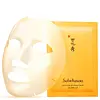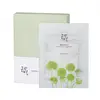What's inside
What's inside
 Key Ingredients
Key Ingredients

 Benefits
Benefits

 Concerns
Concerns

 Ingredients Side-by-side
Ingredients Side-by-side

Water
Skin ConditioningButylene Glycol
HumectantPropanediol
SolventGlycerin
HumectantBetaine
Humectant1,2-Hexanediol
Skin ConditioningCarbomer
Emulsion StabilisingPEG-60 Hydrogenated Castor Oil
EmulsifyingJuglans Regia Seed Extract
Skin ConditioningGlyceryl Polymethacrylate
Xanthan Gum
EmulsifyingTromethamine
BufferingEthylhexylglycerin
Skin ConditioningDisodium EDTA
Adenosine
Skin ConditioningParfum
MaskingDextrin
AbsorbentTheobroma Cacao Extract
Skin ConditioningLimonene
PerfumingScutellaria Baicalensis Root Extract
AstringentHoney
HumectantMadecassoside
AntioxidantRehmannia Glutinosa Root Extract
Skin ConditioningPaeonia Lactiflora Root Extract
Skin ConditioningLilium Candidum Bulb Extract
Skin ConditioningLycium Chinense Fruit Extract
AntioxidantPolygonatum Odoratum Rhizome Extract
Skin ConditioningOphiopogon Japonicus Root Extract
Skin ConditioningLinalool
PerfumingZiziphus Jujuba Fruit Extract
Skin ConditioningNelumbo Nucifera Flower Extract
Skin ConditioningPueraria Lobata Root Extract
HumectantPrunus Mume Fruit Extract
HumectantCitronellol
PerfumingGlycyrrhiza Uralensis Root Extract
Skin ConditioningLentinus Edodes Extract
Skin ConditioningTocopherol
AntioxidantHydrolyzed Soybean Extract
Skin ConditioningPaeonia Albiflora Root Extract
Skin ConditioningZingiber Officinale Root Extract
MaskingWater, Butylene Glycol, Propanediol, Glycerin, Betaine, 1,2-Hexanediol, Carbomer, PEG-60 Hydrogenated Castor Oil, Juglans Regia Seed Extract, Glyceryl Polymethacrylate, Xanthan Gum, Tromethamine, Ethylhexylglycerin, Disodium EDTA, Adenosine, Parfum, Dextrin, Theobroma Cacao Extract, Limonene, Scutellaria Baicalensis Root Extract, Honey, Madecassoside, Rehmannia Glutinosa Root Extract, Paeonia Lactiflora Root Extract, Lilium Candidum Bulb Extract, Lycium Chinense Fruit Extract, Polygonatum Odoratum Rhizome Extract, Ophiopogon Japonicus Root Extract, Linalool, Ziziphus Jujuba Fruit Extract, Nelumbo Nucifera Flower Extract, Pueraria Lobata Root Extract, Prunus Mume Fruit Extract, Citronellol, Glycyrrhiza Uralensis Root Extract, Lentinus Edodes Extract, Tocopherol, Hydrolyzed Soybean Extract, Paeonia Albiflora Root Extract, Zingiber Officinale Root Extract
Water
Skin ConditioningCentella Asiatica Extract
CleansingGlycereth-26
HumectantButylene Glycol
HumectantNiacinamide
Smoothing1,2-Hexanediol
Skin ConditioningHydroxyacetophenone
AntioxidantArginine
MaskingAcrylates/C10-30 Alkyl Acrylate Crosspolymer
Emulsion StabilisingHydroxyethylcellulose
Emulsion StabilisingCarrageenan
Polyglyceryl-4 Caprate
EmulsifyingPolyglyceryl-6 Caprylate
EmulsifyingAdenosine
Skin ConditioningEthylhexylglycerin
Skin ConditioningDisodium EDTA
Helianthus Annuus Seed Oil
EmollientPanthenol
Skin ConditioningArtemisia Princeps Leaf Extract
Skin ConditioningLycium Chinense Fruit Extract
AntioxidantPropanediol
SolventPortulaca Oleracea Extract
Skin ConditioningPanax Ginseng Root Extract
EmollientCamellia Sinensis Leaf Extract
AntimicrobialAnthemis Nobilis Flower Oil
MaskingSodium Hyaluronate
HumectantHydrolyzed Hyaluronic Acid
HumectantHyaluronic Acid
HumectantWater, Centella Asiatica Extract, Glycereth-26, Butylene Glycol, Niacinamide, 1,2-Hexanediol, Hydroxyacetophenone, Arginine, Acrylates/C10-30 Alkyl Acrylate Crosspolymer, Hydroxyethylcellulose, Carrageenan, Polyglyceryl-4 Caprate, Polyglyceryl-6 Caprylate, Adenosine, Ethylhexylglycerin, Disodium EDTA, Helianthus Annuus Seed Oil, Panthenol, Artemisia Princeps Leaf Extract, Lycium Chinense Fruit Extract, Propanediol, Portulaca Oleracea Extract, Panax Ginseng Root Extract, Camellia Sinensis Leaf Extract, Anthemis Nobilis Flower Oil, Sodium Hyaluronate, Hydrolyzed Hyaluronic Acid, Hyaluronic Acid
 Reviews
Reviews

Ingredients Explained
These ingredients are found in both products.
Ingredients higher up in an ingredient list are typically present in a larger amount.
1,2-Hexanediol is a synthetic liquid and another multi-functional powerhouse.
It is a:
- Humectant, drawing moisture into the skin
- Emollient, helping to soften skin
- Solvent, dispersing and stabilizing formulas
- Preservative booster, enhancing the antimicrobial activity of other preservatives
Adenosine is in every living organism. It is one of four components in nucleic acids that helps store our DNA.
Adenosine has many benefits when used. These benefits include hydrating the skin, smoothing skin, and reducing wrinkles. Once applied, adenosine increases collagen production. It also helps with improving firmness and tissue repair.
Studies have found adenosine may also help with wound healing.
In skincare products, Adenosine is usually derived from yeast.
Learn more about AdenosineButylene Glycol (or BG) is used within cosmetic products for a few different reasons:
Overall, Butylene Glycol is a safe and well-rounded ingredient that works well with other ingredients.
Though this ingredient works well with most skin types, some people with sensitive skin may experience a reaction such as allergic rashes, closed comedones, or itchiness.
Learn more about Butylene GlycolDisodium EDTA plays a role in making products more stable by aiding other preservatives.
It is a chelating agent, meaning it neutralizes metal ions that may be found in a product.
Disodium EDTA is a salt of edetic acid and is found to be safe in cosmetic ingredients.
Learn more about Disodium EDTAEthylhexylglycerin (we can't pronounce this either) is commonly used as a preservative and skin softener. It is derived from glyceryl.
You might see Ethylhexylglycerin often paired with other preservatives such as phenoxyethanol. Ethylhexylglycerin has been found to increase the effectiveness of these other preservatives.
Lycium Chinense Fruit Extract comes from a type of goji berry plant.
Goji berries contain polysaccharides, carotenoids and flavonoids. These give it antioxidant properties that protect your skin from free-radical molecules.
Polysaccharides help hydrate the top layer of skin due to its ability to mimic natural carbohydrates.
Learn more about Lycium Chinense Fruit ExtractPropanediol is an all-star ingredient. It softens, hydrates, and smooths the skin.
It’s often used to:
Propanediol is not likely to cause sensitivity and considered safe to use. It is derived from corn or petroleum with a clear color and no scent.
Learn more about PropanediolWater. It's the most common cosmetic ingredient of all. You'll usually see it at the top of ingredient lists, meaning that it makes up the largest part of the product.
So why is it so popular? Water most often acts as a solvent - this means that it helps dissolve other ingredients into the formulation.
You'll also recognize water as that liquid we all need to stay alive. If you see this, drink a glass of water. Stay hydrated!
Learn more about Water